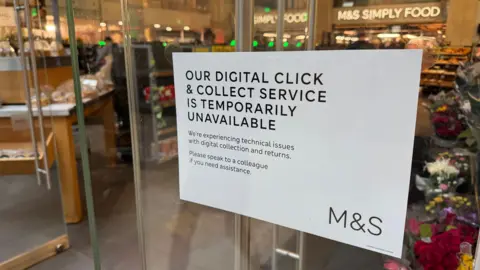The cyberattack against Marks & Spencer (M&S) has caused significant disruption and chaos for over a week, affecting one of the UK’s most recognizable brands. This incident, attributed to a ransomware group named DragonForce, has resulted in millions of pounds in lost sales and a decline in stock value for the retailer. While M&S has remained tight-lipped regarding specifics of the attack—such as the methods employed and the extent of the damage—security experts are now weighing in on the situation and questioning why it is taking so long to resolve.
A notable point of interest is the nature of the disruption. While technical glitches not related to cybersecurity are typically addressed in a matter of hours, the complexity of a ransomware attack poses a greater challenge. Professor Alan Woodward, a cybersecurity expert from Surrey University, asserts that resolving an incident of this magnitude involves detailed analysis to ensure that the malware is fully eradicated from the systems. Everything from inventory management, which determines what needs restocked, to processing card payments, heavily relies on interconnected systems that can become compromised during such attacks.
Lisa Forte, a partner at the cyber security firm Red Goat, echoed this sentiment, mentioning that it is unrealistic to expect a company to restore such essential services within a week, particularly after a ransomware attack. Her statement reflects a broader understanding among cybersecurity professionals that even with a swift response, the evaluation and remediation of compromised systems require meticulous work and significant expertise.
Further complicating the situation is the nature of ransomware itself, often likened to a “digital bomb.” Dan Card, an expert from the BCS (The Chartered Institute for IT), explained that these attacks can incapacitate entire systems, requiring organizations to work tirelessly to respond and recover. Ransomware typically scrambles the data of the attacked organization, demanding payment—often in the form of cryptocurrencies—to unlock it, which creates a moral dilemma for the affected entities. The general consensus among cybersecurity experts is to avoid paying the ransom, as there is no guarantee attackers will honor their agreement and provide access to the data.
Despite the ongoing chaos, M&S has chosen not to comment on specifics related to the attack or whether they plan to pay a ransom. Speculation suggests that the hackers could leverage pressure techniques, such as public declarations of demands, which can escalate the urgency of the situation for the victim.
Exploring the origins of this particular attack leads to speculation about the group behind it. DragonForce is rumored to allow other hackers to utilize their malicious software for financial gain. One suggested collaborator is a group called Scattered Spider, which has previously been associated with notable cyber incidents, including an attack on the MGM Las Vegas hotels in 2023. The name “Scattered Spider” has been linked to a network of younger individuals, even teenagers, involved in these activities, highlighting the evolving and often unpredictable nature of cybercrime.
As concerns mount about customer data security, experts are contemplating whether M&S customers should worry about compromised personal information. Currently, M&S officials have stated that no action is needed from the customers. However, security consultant Rik Ferguson indicated that customers, especially those who may have re-used their account credentials on different platforms, should consider changing their passwords to mitigate any potential risks.
Ultimately, as the situation continues to unfold, the complexity of cyberattacks like that suffered by M&S emphasizes the ongoing battle against cyber threats in today’s digital landscape. The incident serves as a cautionary tale for both companies and consumers about the importance of cybersecurity awareness and resilience in the face of increasing cybercriminal activity.











